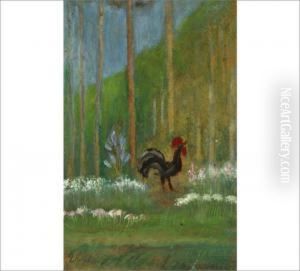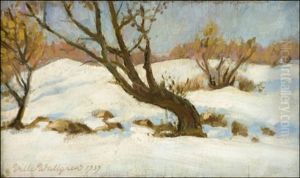Ville Vallgren Paintings
Ville Vallgren, born Carl Wilhelm Vallgren on December 8, 1855, in Porvoo, Finland, was a distinguished Finnish sculptor known for his works in the Symbolist style. He spent much of his career in France, where he became well-acquainted with the Parisian art scene and was influenced by the prevailing artistic movements of the time.
Vallgren began his artistic education in Helsinki but moved to Paris in 1883 to study at the Académie Julian, a private art school popular with foreign students, including many Scandinavians and Americans. The eclectic and cosmopolitan environment of the French capital allowed him to absorb various artistic influences, including Symbolism, which left a lasting imprint on his work.
His sculpture 'The Awakening' (1892) is considered one of his masterpieces and reflects the Symbolist fascination with dreams, mythology, and sensuality. Vallgren's style was characterized by a combination of classical forms with a lyrical, dream-like quality, which was well received in the artistic circles of his time.
Vallgren's success in France did not keep him from maintaining a connection to Finland. He became a member of the Finnish Art Society and was actively involved in Finnish cultural life. His works were often imbued with a sense of Finnish national identity and romanticism. He created several public monuments and sculptures in Finland, including the famous 'Havis Amanda' fountain in Helsinki, unveiled in 1908. This statue of a mermaid emerging from the water became one of the symbols of the city and demonstrated Vallgren's skill in creating works that resonated with the public.
Despite residing in France, Vallgren played a significant role in the development of Finnish art. He was a bridge between Finnish and French art scenes, and his international reputation helped raise awareness of Finnish art abroad. In recognition of his contributions, he was awarded the Legion of Honour by the French government.
Vallgren's career spanned several decades, during which he witnessed and participated in the dynamic changes of the art world. He continued to work and exhibit his art well into the 20th century, adapting and evolving his style while maintaining the Symbolist ethos that defined much of his early work. Ville Vallgren died on October 14, 1940, in Helsinki, having left a lasting legacy in both Finnish and French art.

